|
Here is the front of the orbiter and as you can see
there are thousands of tiles from nose to tail that we'll look at in
more detail later. The large and smaller openings that you see are thrusters
to maneuver the spacecraft while in orbit. These thrusters are on both
sides and are in the rear of the shuttle as well which I'll cover later
as well.
|
|
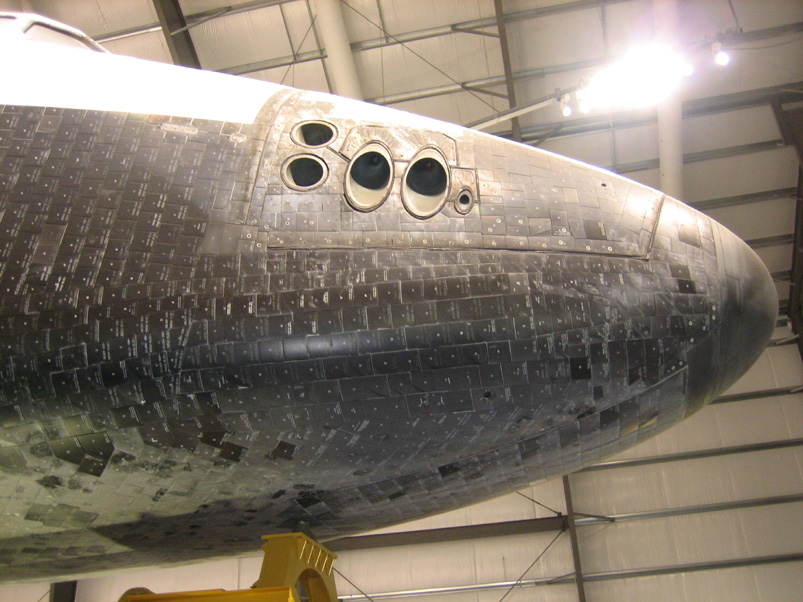 |
|
If you look close you can see the white area is made up
of panels that are about 3' X 5' in size. These panels are made of
Nomex felt blankets which is a flame resistant fiber developed by DuPont
back in the 60's. These panels can withstand temps up to 700 degrees
Fahrenheit. If you're into auto racing then this material is no stranger
to you because racecar drivers have been using it for their fire suits
for many years. All the big players in the space industry like
Lockheed Martin, Rocketdyne or NASA come up with lots of cool things that
are a necessity for them and then eventually they trickle down to the public, like Nomex
for instance. This material is also very light weight and is used to
fill in gaps between the cargo bay doors and other moving surfaces.
While we were walking around some guy asked us if we
wanted to touch the Shuttle. The guy had some small samples of material
that make up the outer layers that endure heat and one of them was Nomex.
The stuff is very lightweight and very strong. He also had a few other
materials that I'll talk about later. There are two
locations for rescue, one that says "cut here for emergency rescue"
to the right and
where the yellow arrow is pointing. In case you can't read the area
above the arrow it says; "1 remove two fasteners, 2 push button to open
door, 3 squeeze and pull T handle to jettison". Below the arrow says,
"eject panel".
|
|
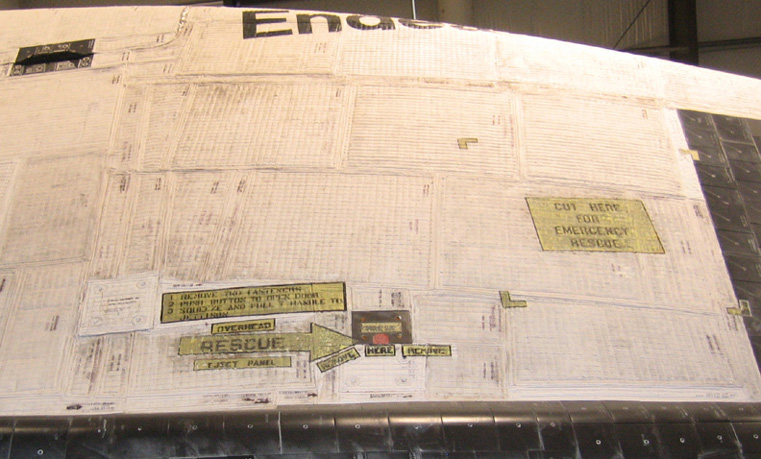 |
|
Do you notice any thing strange or different about this
shot? Check out the flag because it's backwards. I asked about this and
the answer was, if the shuttle were moving and the flag was on a pole,
this is the direction it would be pointing.
|
|
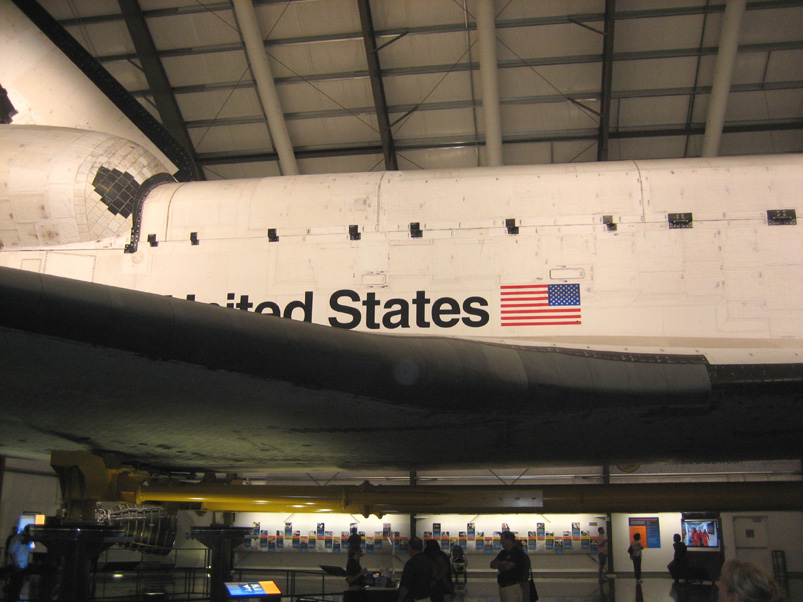 |
|
In this shot you can see some of the tiles and their
random shapes. Most of the tiles are 6" X 6" and vary in thickness from
1" to 5" inches depending on the heat load they encounter during
reentry. These tiles are referred to as High Temperature Reusable
Surface Insulation (HRSI). HRSI tiles provide protection
against temperatures up to 2,300 °F and there are over 20,500 of them.
The HRSI tiles are made of high purity silica fibers.
Ninety percent of the volume of the tile is empty space (air) giving it
a very low density making them very light. The uncoated tiles are bright
white in appearance and look more like a solid ceramic than the foam
like material that they are. The black coating on the tiles is Reaction
Cured Glass made up of several ingredients. Reaction Cured Glass was
applied to all but one side of the tile to protect the porous silica and
to increase the heat sink properties. To waterproof and to make them
more dense a special chemical was injected into them by syringe which
also helped to protect the silica and added additional waterproofing.
This was another one of the samples the guy let us check
out and they were very light. After holding one in my hand It's hard to
believe that something like this could take extreme heat like it does.
Truly amazing!
|
|
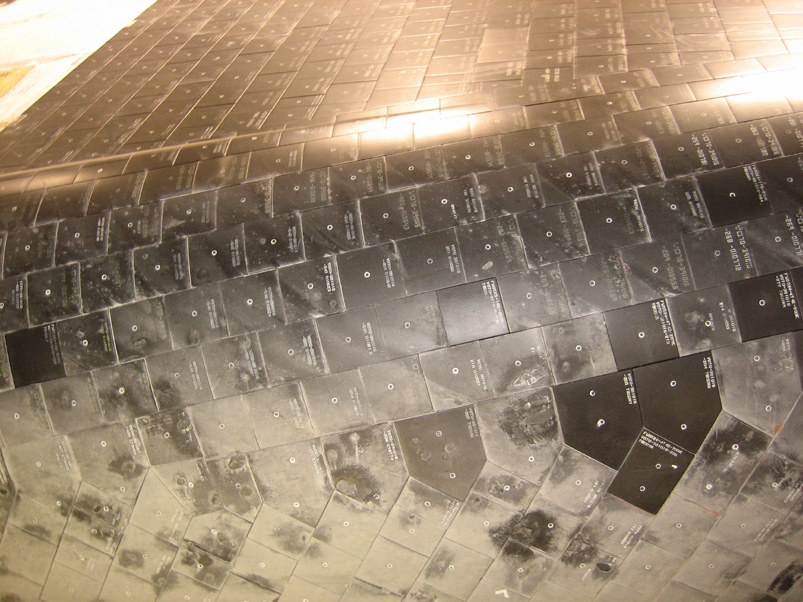 |
|
Here you can see the leading edge of the
wing and the lack of any tiles on it. That's because the tiles are behind
the light gray material called Reinforced Carbon Carbon (RCC). This
material is 1/4" to 1/2" thick and can withstand reentry temps of 2,750
°F which is also on the nose cap. The guy that had the random samples
also had some of this material and it was the heaviest of all. That
makes sense because the nose and leading edge of the wings would see the
most heat and would need the most protection.
RCC is a laminated composite material made from graphite
rayon cloth and impregnated with a phenolic resin. After curing at high
temperature in an autoclave, the laminate was pyrolized (which is a
thermo chemical decomposition of organic material at elevated
temperatures in the absence of oxygen) to convert the resin to carbon.
This was then impregnated with furfural alcohol in a vacuum chamber,
then cured and pyrolized again to convert the furfural alcohol to
carbon. This process was repeated three times until the desired
carbon-carbon properties were achieved.
To provide oxidation resistance for reuse capability, the outer layers
of the RCC were converted to silicon carbide. The silicon carbide
coating protected the carbon-carbon from oxidation. The RCC was highly
resistant to fatigue loading that is experienced during ascent and
entry. It was stronger than the tiles and was also used around the
socket of the forward attach point of the orbiter to the external tank
to accommodate the shock loads of the explosive bolt detonation.
|
|
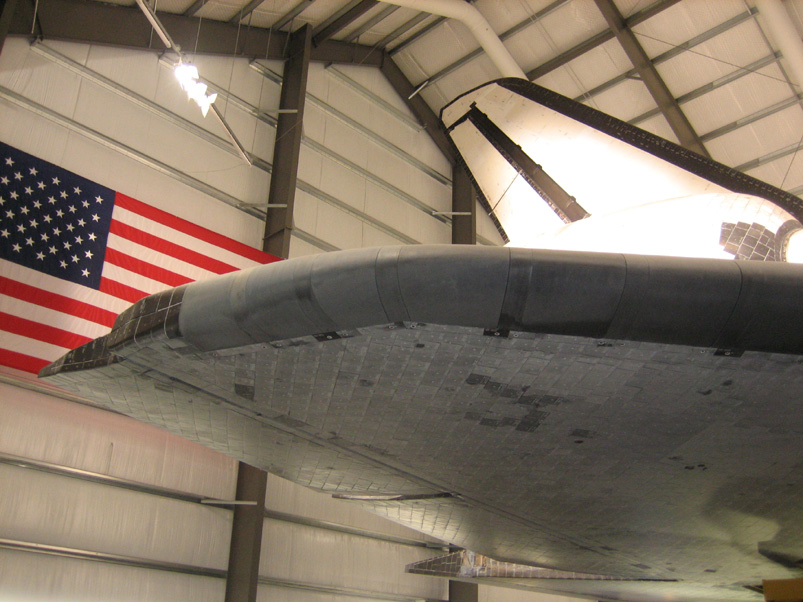 |
|
The orbiter has wings that create lift. It uses a
double-delta wing configuration to achieve the most efficient flight
during hypersonic speed as well as providing a good lift-to-drag ratio
during landing. For control, each wing has an “elevon”. An elevon is a
combination of an elevator and an aileron like a normal airplane has.
On an airplane, the elevator controls the motion of
pitch (nose up, nose down). On most airplanes, the elevator is located
on the horizontal stabilizer as part of the tail section. Ailerons on
most airplanes are at the trailing edge of each wing and control an
airplane’s roll motion. Because of the orbiter’s delta wing
configuration, the elevators and ailerons are combined as elevons and
placed at the trailing edge of each wing.
|
|
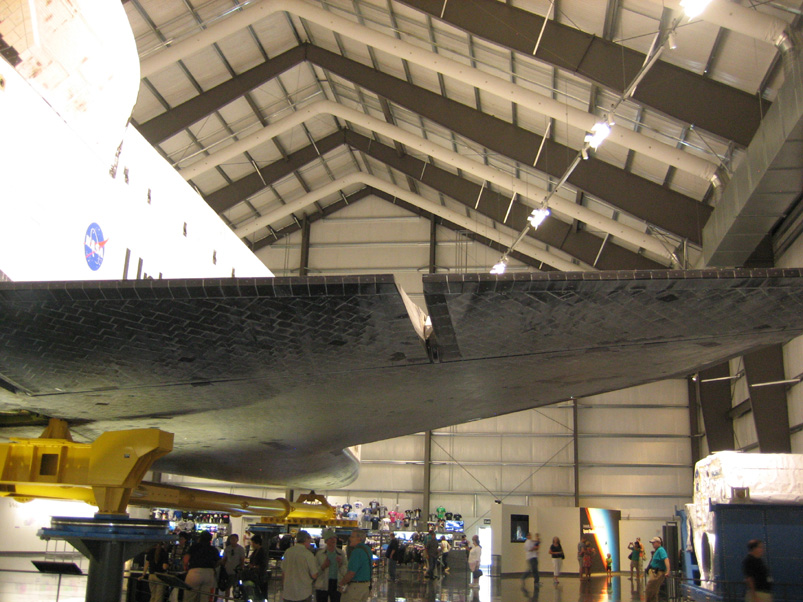 |
|
There is a lot going on in this shot so let's brake it
down section by section.
At the top you can see the vertical stabilizer or
rudder, which controls its yaw (nose left, nose right). The split rudder
on the orbiter works as a rudder and also as a speed brake (found on
most airplanes as a spoiler located on the wing). It does this by
splitting in half vertically and opening like a book. This deflects the
airflow, increases drag and decreases the orbiter’s speed once it's on
the runway during landing. Now the vertical stabilizer and elevons are
useless in the vacuum of space but once it re-enters the earths
atmosphere is when they work to help glide the shuttle to a safe
landing.
Below the rudder are some engines, three big main
engines and two smaller maneuvering engines. The main engines are
reusable and are the worlds most sophisticated rocket engines. These
main engines help propel the shuttle off the launch pad and into orbit
along with the two solid rocket boosters. The solid rocket boosters fall
back to earth using parachutes and are reusable.
The two maneuvering engines steer the shuttle and are
called Orbital Maneuvering Systems (OMS) engines which are located in
pods, one on either side of the tail. These engines place the shuttle
into final orbit, change the shuttle's position from one orbit to
another, and slow the shuttle down for re-entry.
Below the main engines covered in tiles is called a
flap. It provides a thermal (heat) shield for the engines during
re-entry and also provides pitch control (nose up and nose down) during
landings.
|
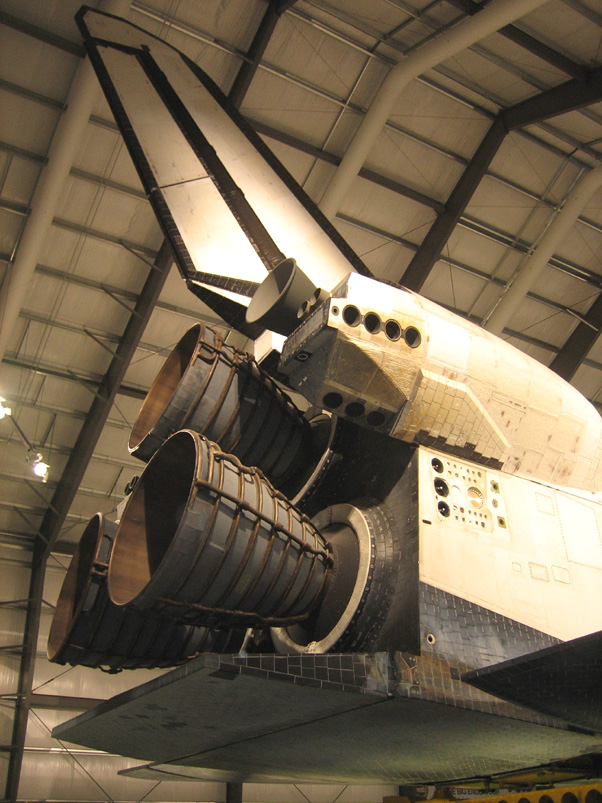
|
|
The main engines operate for about 8 1/2 minutes during
liftoff which is long enough to burn more than 500,000 gallons of
super-cold liquid hydrogen and liquid oxygen propellants stored in the
huge external tank attached to the underside of the shuttle. Liquid
oxygen is stored at –298 degrees Fahrenheit and liquid hydrogen at –423
degrees Fahrenheit. After these main engines shut down, the shuttle is
traveling at about 17,000 mph.
The OMS engines burn a solid propellant and nitrogen
tetroxide oxidizer. When these two substances come in contact, they
ignite and burn automatically (no spark required) in the absence of
oxygen. The fuel and oxidizer are kept in separate tanks, each
pressurized by helium. The helium pushes the fluids through the fuel
lines, meaning no mechanical pumps are required.
|
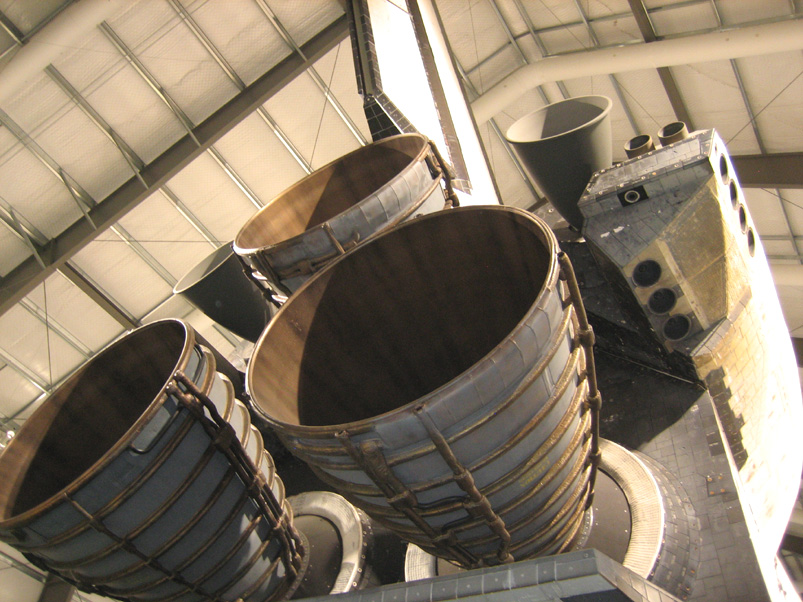
|
|
Each main engine weighs over 7,000 pounds and is 7.5
feet in diameter at the end of its nozzle. As they push the Shuttle
toward orbit, the engines consume liquid fuel at a rate that would drain
an average family swimming pool in under 25 seconds generating over 37
million horsepower with all engines working. The main engines are
gimbaled to provide pitch, yaw and roll control during the ascent.
|
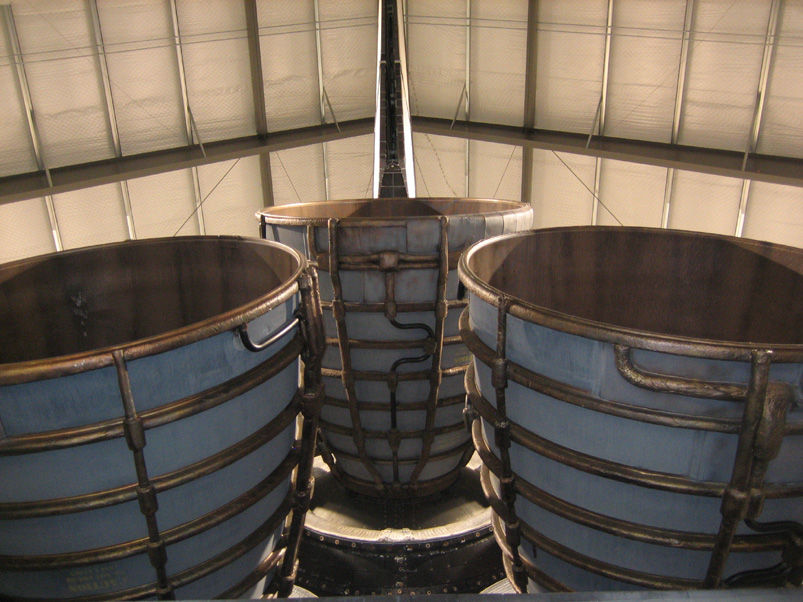
|
|
Here is the RS-25 or space shuttle main engine (SSME) to
give you a better idea of what it looks like. I had to step back a few
feet because it's 14 feet long. It's built in the U.S. by a company
called Rocketdyne and after each flight the engines are removed from the
orbiter, inspected and refurbished before being reused on another
mission.
|
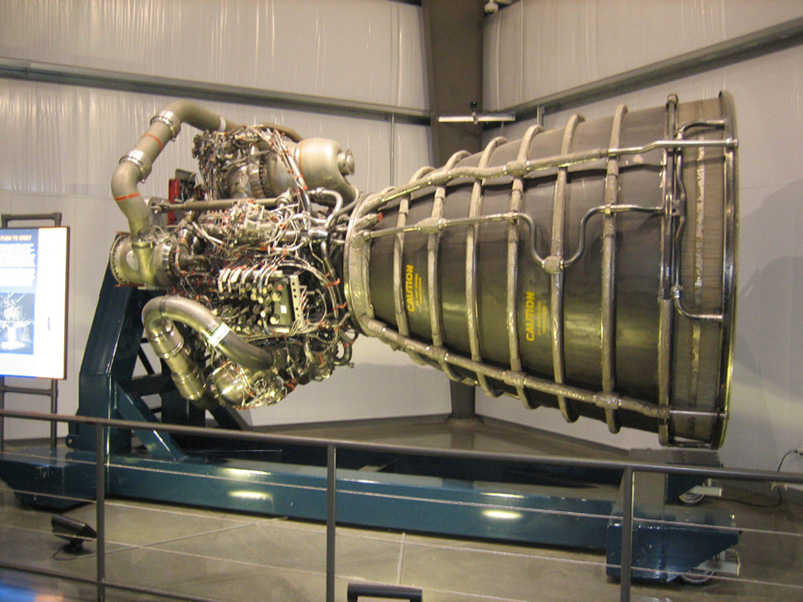 |
|
1
2
3
4
5
6
7
8
9
10
11
12 |